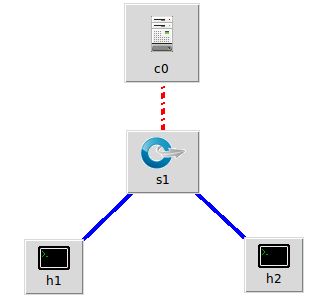1.浏览RYU官网学习RYU控制器的安装和RYU开发入门教程,提交你对于教程代码的理解,包括但不限于:
- 描述官方教程实现了一个什么样的交换机功能?
将接收到的数据包发送到所有端口 - 控制器设定交换机支持什么版本的OpenFlow?
openflow 1.0 - 控制器设定了交换机如何处理数据包?
@set_ev_cls(ofp_event.EventOFPPacketIn, MAIN_DISPATCHER)装饰器告诉Ryu何时应调用装饰的函数- 第一个参数指示应调用此函数的事件类型
- 第二个参数指示开关的状态
- ev.msg是表示packet_in数据结构的对象。
- msg.dp是代表数据路径(开关)的对象。
- dp.ofproto和dp.ofproto_parser是代表Ryu和交换机协商的OpenFlow协议的对象。
- OFPActionOutput类与packet_out消息一起使用,以指定要从中发送数据包的交换机端口。该应用程序使用OFPP_FLOOD标志来指示应在所有端口上发送数据包。
- OFPPacketOut类用于构建packet_out消息。
- 如果使用OpenFlow消息类对象调用Datapath类的send_msg方法,则Ryu会生成联机数据格式并将其发送到交换机。
2.根据官方教程和提供的示例代码(SimpleSwitch.py),将具有自学习功能的交换机代码(SelfLearning.py)补充完整
from ryu.base import app_manager
from ryu.controller import ofp_event
from ryu.controller.handler import MAIN_DISPATCHER
from ryu.controller.handler import set_ev_cls
from ryu.ofproto import ofproto_v1_0
from ryu.lib.mac import haddr_to_bin
from ryu.lib.packet import packet
from ryu.lib.packet import ethernet
from ryu.lib.packet import ether_types
class SimpleSwitch(app_manager.RyuApp):
# TODO define OpenFlow 1.0 version for the switch
# add your code here
OFP_VERSIONS = [ofproto_v1_0.OFP_VERSION]
def __init__(self, *args, **kwargs):
super(SimpleSwitch, self).__init__(*args, **kwargs)
self.mac_to_port = {}
def add_flow(self, datapath, in_port, dst, src, actions):
ofproto = datapath.ofproto
match = datapath.ofproto_parser.OFPMatch(
in_port=in_port,
dl_dst=haddr_to_bin(dst), dl_src=haddr_to_bin(src))
mod = datapath.ofproto_parser.OFPFlowMod(
datapath=datapath, match=match, cookie=0,
command=ofproto.OFPFC_ADD, idle_timeout=0, hard_timeout=0,
priority=ofproto.OFP_DEFAULT_PRIORITY,
flags=ofproto.OFPFF_SEND_FLOW_REM, actions=actions)
# TODO send modified message out
# add your code here
datapath.send_msg(mod)
@set_ev_cls(ofp_event.EventOFPPacketIn, MAIN_DISPATCHER)
def _packet_in_handler(self, ev):
msg = ev.msg
datapath = msg.datapath
ofproto = datapath.ofproto
pkt = packet.Packet(msg.data)
eth = pkt.get_protocol(ethernet.ethernet)
if eth.ethertype == ether_types.ETH_TYPE_LLDP:
# ignore lldp packet
return
if eth.ethertype == ether_types.ETH_TYPE_IPV6:
# ignore ipv6 packet
return
dst = eth.dst
src = eth.src
dpid = datapath.id
self.mac_to_port.setdefault(dpid, {})
self.logger.info("packet in DPID:%s MAC_SRC:%s MAC_DST:%s IN_PORT:%s", dpid, src, dst, msg.in_port)
# learn a mac address to avoid FLOOD next time.
self.mac_to_port[dpid][src] = msg.in_port
if dst in self.mac_to_port[dpid]:
out_port = self.mac_to_port[dpid][dst]
else:
out_port = ofproto.OFPP_FLOOD
# TODO define the action for output
# add your code here
actions = [datapath.ofproto_parser.OFPActionOutput(out_port)]
# install a flow to avoid packet_in next time
if out_port != ofproto.OFPP_FLOOD:
self.logger.info("add flow s:DPID:%s Match:[ MAC_SRC:%s MAC_DST:%s IN_PORT:%s ], Action:[OUT_PUT:%s] ", dpid, src, dst, msg.in_port, out_port)
self.add_flow(datapath, msg.in_port, dst, src, actions)
data = None
if msg.buffer_id == ofproto.OFP_NO_BUFFER:
data = msg.data
# TODO define the OpenFlow Packet Out
# add your code here
out = datapath.ofproto_parser.OFPPacketOut(datapath=datapath, buffer_id=msg.buffer_id, in_port=msg.in_port, actions=actions, data=data)
datapath.send_msg(out)
print ("PACKET_OUT...")3.在mininet创建一个最简拓扑,并连接RYU控制器
python脚本:
from mininet.topo import Topo
class MyTopo( Topo ):
def __init__( self ):
Topo.__init__( self )
s1=self.addSwitch('s1')
for i in range(1,3):
hw = self.addSwitch( 's{}'.format( i ) )
self.addLink(hw,s1)
topos = { 'mytopo': ( lambda: MyTopo() ) }
